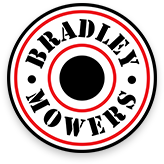A clean, healthy lawn is a desirable and enjoyable feature of your home and property. Mowing the lawn at the right times is critical to keeping your lawn healthy and vigorous. Healthy lawns typically display a deep lush green color, no weeds or bare spots, and thick grass blades about 2 inches in height.
A general rule of thumb is to mow your lawn when the grass blades reach around 3 inches in height. Fast-growing lawns need to be mowed more frequently.
The best time to mow depends primarily on the weather and your lawn's condition.
Work Around Weather and Water Conditions
Water plays an important role in determining the best times to mow your grass. A lawn that is wet from sprinklers, rain or morning or evening dew is not ideal. Wet grass is harder to cut clean, and wet mower blades tear grass blades, leaving a ragged edge. Torn grass blades easily turn brown and are the perfect entry point for fungi and diseases.
Mowing before a rainfall is an excellent time to mow the grass, as the new moisture input penetrates deeper and helps the grass to recover. Mid-morning is usually a good time — some even say this is the best time — to mow. Cutting is easier, since the morning dew has evaporated or been absorbed by the lawn and soil, and yet the day is not too hot so you minimize drying out, sun burning and otherwise stressing your grass. Your lawn has time to heal and recover from mowing before nightfall.
Later in the mid-afternoon may also be a good time to mow, depending again on the weather. Cutting grass in the evening is not usually recommended. Night often brings more dew moisture and potentially increases the risk of fungi and disease finding and infecting your newly cut lawn.
Consider Your Lawn's Health
The best time to mow your lawn also revolves around your lawn's condition and treatments you're planning. If you're aerating or fertilizing, for example, your mowing schedule needs to be coordinated. Mowing before other lawn treatments are applied is generally good practice.
Waiting at least 48 hours to mow after fertilizing a lawn is a good idea. The nutrients need time to be absorbed into the soil. Similarly, it's best to wait until aeration treatments are fully complete before mowing — often, it takes a week or more to realize all the benefits of soil aeration. Seeding, overseeding and reseeding processes also require time to work, and so you should always wait before going ahead and mowing the lawn.
